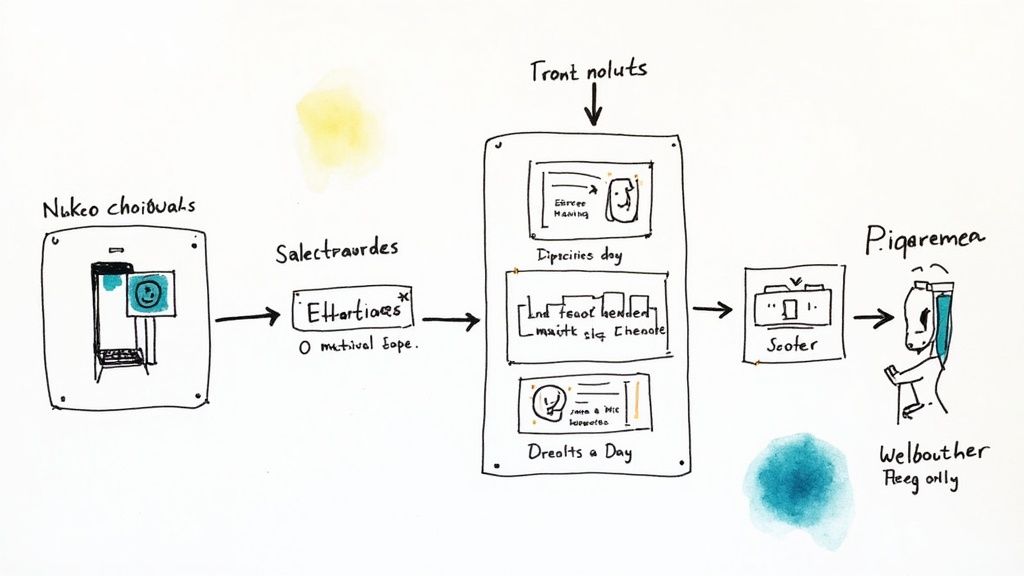How to Create an AI Chatbot: The Ultimate Guide for Modern Businesses
Understanding Modern AI Chatbot Technologies

AI chatbots have come a long way from their early rule-based versions. Thanks to major progress in Natural Language Processing (NLP) and Machine Learning (ML), today's chatbots can understand and respond to human conversations with impressive accuracy. Instead of just matching keywords, they can grasp context and meaning to have real back-and-forth exchanges. Let's explore what makes these modern chatbots tick and how to build one that works well.
Key Components of Modern AI Chatbots
Modern AI chatbots rely on several essential pieces working together. Each component plays a specific role in helping the chatbot understand users, craft good responses, and get better over time.
- Intent Recognition: This helps chatbots figure out what users are trying to do. For instance, when someone asks "Do you deliver to Boston?", the chatbot needs to understand they're asking about delivery options for a specific location. Getting this right is crucial for giving helpful answers.
- Entity Extraction: This involves picking out important details from what users say. Taking the delivery question above, "Boston" would be extracted as a location entity. Other examples might include product names, dates, or account numbers that help the chatbot give more specific responses.
- Context Management: Good chatbots can follow a conversation thread. If you ask about a product and then say "How much does it cost?", the chatbot remembers which product you mean. This makes conversations feel more natural, like talking to a real person.
- Dialogue Management: This guides how conversations flow. It helps chatbots handle topic changes, unexpected questions, and keep discussions on track. Think of it as the conductor making sure all parts of the conversation work together smoothly.
The Power of NLP and ML
NLP gives chatbots their language smarts - helping them understand everyday speech, including informal language and different ways of asking the same thing. ML is what lets chatbots improve through experience. As they talk with more users, they get better at understanding questions and giving useful answers.
The combination of these technologies means chatbots can learn from each interaction. They spot patterns in how people ask questions and figure out which answers work best. This ongoing learning process helps them become more helpful over time.
Recent improvements in NLP and ML keep expanding what chatbots can do. For anyone building a chatbot today, understanding these core technologies is key to creating something that truly helps users. As these tools get even better, we'll see chatbots that can handle more complex conversations and tasks, making them even more valuable for businesses and their customers.
Designing Your Chatbot Strategy for Success

Creating an effective AI chatbot requires more than technical knowledge - you need a clear strategy that aligns with your business goals. A successful chatbot serves as a practical business tool that delivers real value to your organization and customers. Let's explore the key steps to develop a chatbot strategy that gets results.
Defining Your Chatbot's Purpose and Scope
The first step is identifying exactly what business problems your chatbot will solve. Will it focus on customer service, lead generation, or user onboarding? Having specific goals helps guide development in the right direction. For instance, an e-commerce chatbot might handle product questions, order tracking, and personalized recommendations. By maintaining a focused approach rather than trying to do everything at once, you can build a more effective solution.
It's equally important to set clear boundaries around what your chatbot will and won't do. Consider factors like which types of customer interactions it will handle and its hours of operation. Setting these parameters upfront helps manage expectations and allows for more targeted development and testing. This focused scope ultimately leads to better performance and user satisfaction.
Creating a Chatbot Persona That Resonates
After defining the purpose and scope, focus on developing your chatbot's personality. The persona should match your brand voice and connect with your target audience. Think about whether a friendly, casual tone or a more professional approach better suits your needs. For example, a gaming company's chatbot might use playful language and jokes, while a bank's chatbot would maintain a more formal, business-like manner to build trust.
But personality goes beyond just tone - it includes the chatbot's overall communication style, word choices, and even its name. All these elements should work together to create a consistent experience that feels natural to users. When done well, a strong persona helps turn your chatbot into an extension of your brand that customers enjoy interacting with.
Measuring Success: Key Metrics for Chatbot Performance
A complete chatbot strategy must include clear ways to measure success. Focus on concrete metrics like customer satisfaction scores, percentage of automated responses, time to resolution, and cost reductions. These numbers show how well your chatbot performs and highlight areas that need improvement. A chatbot that successfully handles 80% of customer questions without human help demonstrates strong automation capabilities.
Regular analysis of these metrics enables you to fine-tune your approach over time. By closely tracking what works and what doesn't, you can adjust your chatbot to better meet customer needs and business objectives. This data-driven method helps ensure your chatbot continues delivering value and justifying your investment in the technology.
Choosing the Right Technology Stack
Selecting the appropriate technology stack is just as crucial as having a clear strategy when building an AI chatbot. The tools, platforms and frameworks you choose will determine your chatbot's core capabilities and how well it works with your existing systems. Let's explore the key factors to consider when evaluating chatbot development options.
Essential Platform Selection Criteria
When choosing a technology stack for your AI chatbot, focus on these critical factors to make the best decision for your needs:
- Integration Options: Your chatbot needs to work smoothly with your current business systems like CRM and marketing tools. Look for platforms offering ready-made integrations with your core systems. For instance, if your company uses Salesforce, picking a platform with built-in Salesforce connectivity makes implementation much easier.
- Growth Potential: Consider how well the platform can handle increased usage as your user base grows. The ideal solution should maintain consistent performance even during high-traffic periods without requiring major changes. This is particularly important if you expect significant user growth.
- Technical Requirements: Take an honest look at your team's technical skills. Some platforms need extensive coding knowledge, while others offer simpler drag-and-drop interfaces. Match the platform's technical demands with your team's capabilities to avoid implementation challenges.
- NLP Capabilities: The Natural Language Processing engine forms the foundation of your chatbot's ability to understand and respond to users. Each platform uses different NLP technology with its own strengths. Test how well different options handle your specific use cases and language requirements.
- Budget Considerations: Platform costs vary widely, from free basic tiers to enterprise pricing based on usage. Consider both upfront and ongoing costs, including any per-message fees or subscription charges. Look for pricing that aligns with your expected usage patterns and budget constraints.
Custom Build vs Ready-Made Platform
One key decision is whether to build a custom chatbot from scratch or use an existing platform. Here's how these options compare:
- Custom Development: This path gives you complete control over features and functionality, perfect for unique requirements that off-the-shelf solutions can't meet. However, it requires significant development resources and ongoing maintenance work.
- Existing Platforms: These solutions offer faster deployment and lower initial costs, often including useful pre-built features. While customization options may be more limited, they're ideal for companies wanting to launch quickly without extensive development effort.
| Feature | Custom Build | Existing Platform |
|---|---|---|
| Flexibility | High | Limited |
| Development Time | Long | Short |
| Cost | High | Low |
| Maintenance | High | Low |
| Control | High | Limited |
The choice between building and buying depends on several practical factors: your specific feature needs, available technical resources, and budget constraints. Consider how complex your chatbot needs to be and what internal resources you can dedicate to development and maintenance. This decision shapes not just the development process but the long-term success of your chatbot project.
Crafting Engaging Conversational Experiences

Creating an effective AI chatbot requires more than just technical functionality - it needs to deliver conversations that feel natural and meaningful to users. When designing your chatbot, focus on building interactions that flow smoothly and provide real value. The way you structure these conversations can turn a basic chatbot into a helpful digital assistant that users actually want to engage with.
Designing Natural Dialogue Flows
The foundation of a good chatbot is conversation that feels human and intuitive. Rather than bombarding users with a menu of options, guide them naturally through questions to understand their needs. For instance, a chatbot could start by asking about the user's general goals before diving into specific details - similar to how an experienced customer service representative would handle an interaction. This creates a more organic back-and-forth that users find easier to follow.
Context awareness is another key element of natural dialogue. Your chatbot should remember important details that users share and reference them appropriately later in the conversation. If someone mentions they're looking for products to ship to Canada, the chatbot shouldn't later ask which country they're in. These small but important details help create fluid conversations that don't feel repetitive or mechanical.
Building a Compelling Chatbot Personality
Your chatbot's personality shapes how users perceive and interact with it. This comes through in its word choices, communication style, and even its name. The key is matching the personality to your brand and audience. A banking chatbot might use precise, professional language, while a travel chatbot could be more casual and enthusiastic. Either way, the personality should feel authentic rather than forced.
When you maintain a consistent personality across all interactions, users begin to build familiarity and trust with your chatbot. They know what to expect and feel more comfortable engaging with it regularly. This comfort leads to more productive conversations and better outcomes for both users and your business.
Handling Complex Conversations and Edge Cases
While simple conversations are important to get right, your chatbot also needs strategies for handling unexpected situations. Users often ask questions in unusual ways, bring up topics outside the chatbot's knowledge, or take conversations in surprising directions. Plan for these scenarios to keep interactions smooth and helpful.
One practical approach is creating thoughtful fallback responses. When your chatbot encounters something it can't handle, it should gracefully acknowledge its limitations and offer alternative help - perhaps by connecting the user with a human agent. Beyond that, track these edge cases to spot patterns and opportunities for improvement. By studying how users actually interact with your chatbot, you can steadily expand its capabilities to handle a wider range of conversations effectively.
Mastering AI Training and Testing

Building an effective AI chatbot requires careful attention to training and testing. Just like teaching a person, your chatbot needs well-organized information and regular practice to develop solid conversational skills. The key is selecting relevant training data, applying the right teaching methods, and thoroughly testing how well the chatbot performs.
Data Collection and Preparation: The Foundation of Your Chatbot
Your chatbot's ability to help users directly depends on its training data quality. Start by gathering real customer conversations that show how people actually communicate with your business. For a retail chatbot, you'll want examples of common questions about products, shipping, returns, and sizing. Make sure to include different ways people ask the same questions - some might say "How much is shipping?" while others write "What r ur delivery costs?" This variety helps your chatbot understand and respond naturally to different communication styles.
The best sources for training data are your existing customer service records - past chat logs, support tickets, and FAQ documents. Clean and organize this information so your chatbot can learn the right patterns. Pay special attention to including examples of common spelling mistakes, casual language, and various ways people phrase their questions.
Training Methodologies: Shaping Your Chatbot's Intelligence
After preparing your data, you'll need to choose how to train your chatbot. Each training method has specific strengths. Supervised learning works like a structured lesson plan - you show the chatbot examples of questions and their correct answers. Unsupervised learning lets the chatbot explore the data on its own to find patterns, which can uncover useful connections you hadn't considered. Reinforcement learning teaches through practice and feedback, similar to how people learn from experience.
Pick the method that matches your goals. Supervised learning works well for straightforward customer service tasks. Unsupervised learning helps handle unexpected questions. Reinforcement learning is great for developing more natural conversation flow. You can also combine approaches as your chatbot grows more sophisticated.
Testing and Refinement: Ensuring Accuracy and User Satisfaction
Regular testing helps catch problems and improve your chatbot's performance. Start with automated tests that check basic functions - can the chatbot understand common questions? Does it give helpful answers? But machines can't catch everything, so include human testers who can evaluate the conversation quality. They'll notice if responses feel unnatural or miss the point of questions.
Use feedback from both automated and human testing to make your chatbot better. Look for patterns in where it struggles - maybe it has trouble with certain topics or misunderstands specific phrases. Use these insights to add more training examples and adjust how the chatbot learns. Keep testing and improving regularly - this ongoing process helps your chatbot stay useful and reliable as user needs change. A well-maintained chatbot becomes more valuable to your business and customers over time.
Scaling Your Chatbot for Growth
Once you've successfully launched your AI chatbot, you'll need a solid plan to help it grow alongside your business. This means paying close attention to how it performs, making regular improvements, and ensuring it can handle increased demands. Let's look at how companies successfully scale their chatbots while maintaining quality and getting the most value from their investment.
Handling Increased User Loads
When more customers start using your chatbot, its systems need to keep up smoothly. That's why choosing the right technical foundation matters from day one. For instance, if you use a cloud-based platform, it can automatically add more computing power when traffic spikes - similar to opening extra checkout lanes when a store gets busy. Good platforms also spread user traffic across multiple servers to prevent slowdowns. This helps ensure your chatbot stays quick and responsive, even during the busiest times.
Expanding Chatbot Capabilities
Making your chatbot more capable isn't just about adding random features - it's about smart growth based on real needs. Start by looking at user feedback and chat logs to spot patterns. For example, if you notice many customers asking about shipping policies, focus on building out those answers first. This targeted approach means you're investing time and resources where they'll help customers most effectively.
Maintaining Performance at Scale
Just like a car needs regular tune-ups, your chatbot needs ongoing care to run well as it grows. Keep track of important numbers like how quickly it responds, how often it makes mistakes, and what users think of it. When you spot issues - like slower response times or confused answers - you can fix them before they frustrate your customers. Regular check-ups help catch small problems before they become big ones.
Measuring ROI and Optimizing Performance
To show your chatbot's real value, focus on measuring what matters most to your business. Track specific goals like customer happiness scores, new sales leads generated, or money saved on support costs. Look at actual conversations to find what works best and what needs improvement. This helps turn your chatbot from a basic tool into a key part of your business strategy that keeps getting better over time.
Ready to grow your business with a chatbot that scales smoothly? Sitebot makes it easy to create and grow a custom chatbot that fits your brand perfectly. Get started with Sitebot now!


